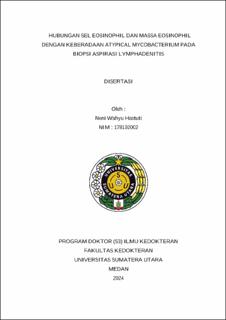| dc.contributor.advisor | Munir, Delfitri | |
| dc.contributor.advisor | Kamarlis, Reno Keumalazia | |
| dc.contributor.advisor | Sinaga, Bintang Yinke Magdalena | |
| dc.contributor.author | Hastuti, Neni Wahyu | |
| dc.date.accessioned | 2024-09-02T03:10:55Z | |
| dc.date.available | 2024-09-02T03:10:55Z | |
| dc.date.issued | 2024 | |
| dc.identifier.uri | https://repositori.usu.ac.id/handle/123456789/96500 | |
| dc.description.abstract | Background. The diagnosis of tuberculous lymphadenitis on aspiration biopsy preparations can be established based on the presence of dark specks (DS). DS is rather dark-colored stuff contained in eosinophilic granular material seen on the aspirate of tuberculous lymphadenitis.
Generally, tuberculous lymphadenitis can be treated with anti-tuberculosis drugs within 6-9 months. However, some cases cannot be cured within that period, it must be for a longer period time, 2 (two) years or more. When the aspiration biopsy specimens of these recent cases were re-examined, it appeared that in addition to DS, eosinophils were also seen, and when the aspirate of this preparation was examined by polymerase chain reaction (PCR), atypical mycobacterium (ATM) could be turned out
Aim. This study aimed to determine the relationship between eosinophils and the presence of ATM on aspiration biopsy preparations of lymphadenitis including tuberculous lymphadenitis and the possibility of ATM as the cause of multidrug-resistant (MDR) in patients with tuberculous lymphadenitis.
Materials and Methods: Included in this study 70 cases were diagnosed as lymphadenitis including tuberculous lymphadenitis. Out of the 70 cases, 37 cases were with ATMs, and 33 cases were without ATMs. Out of 37 cases with ATM, 34 cases with eosinophils positive (+), and 3 cases with eosinophils negative (-). Out of 33 cases without ATM: 19 cases of eosinophils (+), and 14 cases of eosinophils (-).
There were 26 cases of tuberculous lymphadenitis. 14 of the cases presented atypical mycobacterium of various variants: Bovis, Avium, Kansasi, and Fortuitum. Statistical evaluation was performed using the Chi-square test and a p-value<0.001 was considered significant.
Results: The existence of eosinophils is significantly associated with the presence of atypical mycobacterium (p<0.001).
Conclusion: Eosinophils can be beneficial as an indicator of the presence of atypical mycobacterium which in turn can be the cause of multidrug resistance if these bacteria grow together with tuberculosis bacteria. | en_US |
| dc.language.iso | id | en_US |
| dc.publisher | Universitas Sumatera Utara | en_US |
| dc.subject | Dark Specks | en_US |
| dc.subject | Eosinophil | en_US |
| dc.subject | Atypical Mycobacterium | en_US |
| dc.subject | Tuberculous Lymphadenitis | en_US |
| dc.subject | SDGs | en_US |
| dc.title | Hubungan Sel Eosinophil dan Massa Eosinophil dengan Keberadaan Atypical Mycobacterium pada Biopsi Aspirasi Lymphadenitis | en_US |
| dc.title.alternative | Relationship of Eosinophils with the Presence of Atypical Mycobacterium in Aspiration Biopsy Lymphadenitis | en_US |
| dc.type | Thesis | en_US |
| dc.identifier.nim | NIM178102002 | |
| dc.identifier.nidn | NIDN0026015401 | |
| dc.identifier.nidn | NIDN0028027202 | |
| dc.identifier.kodeprodi | KODEPRODI11001#Ilmu Kedokteran | |
| dc.description.pages | 153 Pages | en_US |
| dc.description.type | Disertasi Doktor | en_US |


